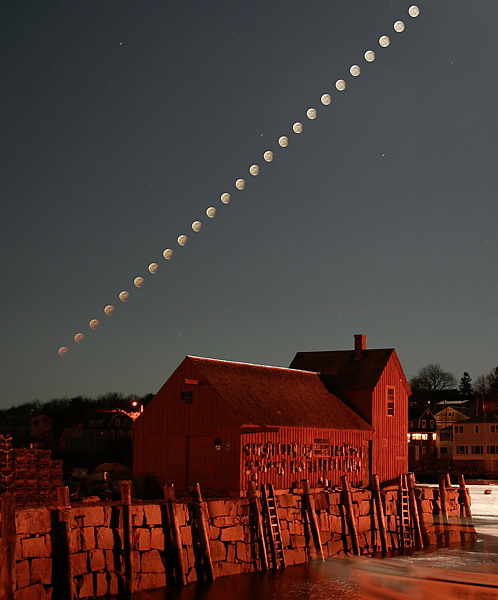Minor Lunar Eclipse Occurs Wednesday: Moon Photography Tips

Editor's Note: The Slooh live webcast of today's eclipse has been canceled due to bad weather at the observation sites.
For observers on the U.S. West Coast, Alaska, and Hawaii, photographing a lunar eclipse early Wednesday (Nov. 28) is pretty straightforward: You’ll need to use basically the same camera gear and technique as when shooting an un-eclipsed full moon.
Wednesday's lunar eclipse will be a relatively minor event as eclipses go. The full moon will pass through the outer edge of Earth's shadow, called the penumbra, to create a so-called penumbral lunar eclipse. The entire eclipse will be visible from East Asia, Australia, Hawaii and Alaska, and begins at 7:15 a.m. EST (4:15 a.m. PST, 1200 GMT). From start to finish, it will last just under five hours.
You can watch the lunar eclipse live on SPACE.com here via the Slooh Space Camera.
First of all, you need a way of enlarging the image of the moon's disk in the frame of your camera. This means shooting through a telescope or telephoto lens with a focal length of 500 millimeters, or more, to capture details on the moon's surface such as its dark markings (called the "maria") as well as the bright, rayed impact craters. [How to Photograph Lunar Eclipses (Photo Guide)]
At this magnification, any camera shake will be apparent so you cannot hold the telescope or telephoto lens by hand. The best way to get steady shots of the moon is to mount your photo gear on a tripod that is beefy enough to support the combined weight of your setup. If you’re using a refracting telescope, you can attach the camera directly to the focuser using the appropriate T-ring and T adapter.
Check your local camera retailer if they have these accessories in stock.
Breaking space news, the latest updates on rocket launches, skywatching events and more!
To reduce camera shake, don’t push the shutter button with your finger. Try to operate it using a long electronic cable release, or use the camera’s delay timer. The mirror slap in digital SLR cameras can also blur images, especially at slow shutter speeds. If possible, lock the camera’s viewfinder mirror up before each shot to keep vibrations to a minimum (consult your camera manual on how to do this).
Obtaining sharp images of the moon depends on how precisely you can bring your telescope/camera combination into focus. Many DSLR cameras now offer "live view" mode, which allows you to see what the camera sensor sees, using its built-in LCD screen. You can zoom in on the image to up to 10X magnification to check its focus. If you want, you can prefocus your camera before the eclipse using the planet Jupiter or the bright star Aldebaran.
Since the moon will graze only the penumbra (the faint outer fringe of the Earth’s shadow), keep your exposure times short so you don’t overexpose the lunar disk. This is especially true for observers in Alaska and Hawaii, where the eclipse occurs higher in the sky, giving a much darker sky background. Use an ISO “speed” setting of 400 or so, and take some test shots prior to the eclipse.
For skywatchers on the West Coast, it’s going to be a challenge to determine beforehand the best exposure to use since the eclipsed moon will be setting just as the sun is rising. The contrast between the moon and the rapidly brightening sky might be rather low, so it’s best to “bracket” your exposures. Switch your camera controls to M (manual) and shoot the eclipse using a variety of shutter speeds to see which ones would come out best and use that as a guide.
Don’t forget: DSLR cameras are not the only ones that can capture the eclipse. In a pinch, your point-and-shoot pocket digital camera or smartphone can also take decent snapshots of the eclipse through a telescope. All you need to do is to hold the camera or phone close to the telescope’s eyepiece without touching it.
Choose an eyepiece that offers a wide field of view and long eye relief so you can easily frame the shot in the LCD screen. Use the cameras’ auto-focus and auto-exposure modes, and zoom in on the projected image to eliminate any vignetting. Smartphones have the added advantage of allowing you to email and share the images right away with other people.
After the eclipse, you can use image-editing software such as Adobe Photoshop to perform basic adjustments in the images’ brightness, contrast, sharpness, and color balance. Advanced users can also select Photoshop’s Levels and Curves tools to enhance the lunar eclipse’s subtle shading.
Good luck and clear skies!
Editor's note: If you snap a photo of the penumbral lunar eclipse of 2012 on Nov. 28 and would like to share it with SPACE.com for a story or gallery, send images, comments and viewing location information to managing editor Tariq Malik at: tmalik@space.com.
Veteran astrophotographers Imelda Joson and Edwin Aguirre have observed more than a dozen partial and total lunar eclipses, plus a few penumbral ones, during their three decades of skywatching.
Imelda B. Joson is a veteran astrophotographer, as well as an eclipse chaser and world traveler. With her husband, Edwin Aguirre, she has organized, led and/or participated in 11 solar eclipse expeditions in North America, Asia and Africa. The pair also conceptualized and created National Astronomy Week, an event that celebrates and publicizes astronomy in the Philippines.



